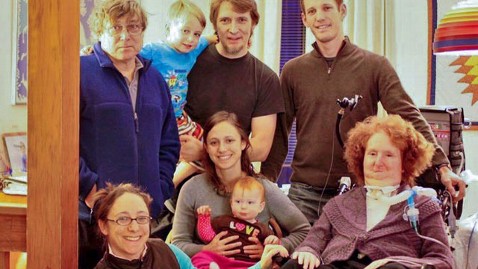Deciding to Live With ALS, Not Die From It

Catherine Wolf, right, pictured with her husband, her daughters, her sons-in-law and her grandchildren. (Image courtesy of Catherine Wolf)
By Catherine G. Wolf:
It was September 1997. I had hoped the weakness in my leg would be treatable, but my doctor shook his head. The intravenous immunoglobulin treatments he'd been giving me for a possible motor neuropathy weren't working, leading him to conclude I had "probable ALS."
I knew little about the disease, commonly known as Lou Gehrig's disease. I asked, "Do people die?" He looked away and said, "Sometimes." I started to cry, knowing that "sometimes" meant "always." How could I have this awful disease? I ate healthy, exercised, was thin and was rarely sick.
That was 15 and a half years ago, 17 years after my first symptom. At first I resisted the diagnosis and clung to the hope that I had something else - anything else. But a year later, after seeking second, third and fourth opinions, I reluctantly accepted it. Most people diagnosed with ALS die within two to five years, a mere 10 percent survive more than 10.
Living With Lou Gehrig's Disease, Blocked From Drug Trials
I immediately decided that I would do whatever it took to make it into that 10 percent. My daughters, Laura and Erika, were just 18 and 22, far too young to say goodbye. I know some people make the decision to not use life-prolonging interventions, such as a feeding tube, noninvasive breathing support or a ventilator. Susan Spencer Wendel, author of the book, " Until I Say Good-Bye," has said she will not use any of these interventions. While I respect her decision, it is not right for me.
In the fall of 1999, I recorded myself saying my name, the names of family members and a few standard greetings. I also recorded two favorite family jokes. What goes "ha ha, thunk"? A man laughing his head off. What's green and hangs from trees? Giraffe snot. They have survived at least three computers, and I use them today in E-triloquist, a speech program that allows recorded phrases, as well as text-to-speech. Who says there's no fun in ALS?
Fast forward to May 2, 2001. After a bad night with the BiPAP machine that helped me breathe at the time, I found myself on my back in the emergency room of Columbia-Presbyterian hospital. I was faced with the decision of whether to have a tracheostomy, a procedure that would allow me to breathe with a ventilator. As victims of car accidents flooded the ER, the ALS team tried to convince me it was the right time.
I remember the nurse practitioner, a long-time member of the team, said that refusing would be like writing "DNR" - do not resuscitate - on my chart. But I had researched the changes that tracheostomy would bring, and I just wanted to delay them a few months.
For one thing, I knew I'd never be alone again because of the constant need to remove secretions from my lungs. But my husband, Joel, held my hand and whispered, "It's really time."
I asked, "Will I be able to go to Erika's graduation in Boston early in June?"
The answer was yes. I decided I'd rather have the tracheostomy six months early than six months late.
That was 12 years ago this May. I not only made it to Erika's graduation, but Laura's as well. I have seen them both married and produce grandchildren. I wouldn't trade my role as GrandCat for anything. Of course, there were adjustments resulting from my tracheostomy. But I am sure I made the right decision in the emergency room. Next time, I will tell you about my ALS advocacy activities.
Catherine Wolf, 66, is a psychologist and expert in the field of human-computer interaction. She is participating in research on brain-computer interface, technology on which she might one day rely to communicate.
"A Day in the Life" is a series of blogs written by people who are living with medical conditions.